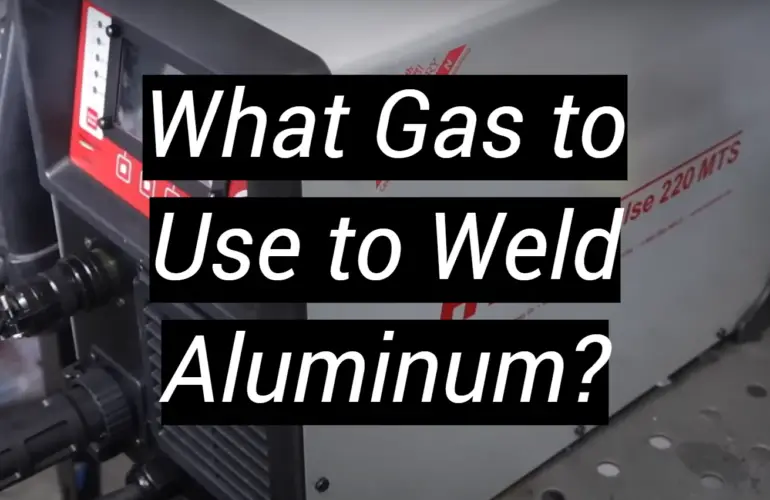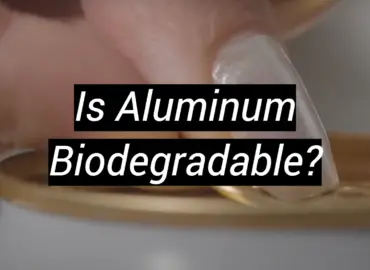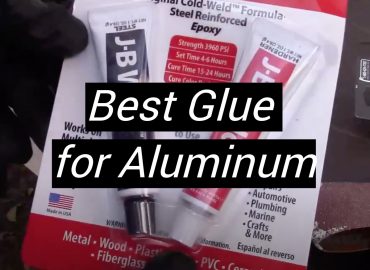When it comes to welding aluminum, selecting the right type of gas for your project is essential. Different types of welding require different gas types. Whether it’s a simple repair job or an intricate fabrication project, using the wrong gas can negatively impact the outcome. Read to learn what gas you need to use when welding aluminum and why it makes such a difference.
What Makes Aluminum Different from Other Metals?
Aluminum is a strong, lightweight metal that offers unique benefits to welders. Its low density and malleability make it ideal for welding projects that require intricate design work or complex shapes. However, aluminum has some unique challenges compared to other metals when it comes to welding. Here are the five most important ones [1]:
- Aluminum has a low melting point of 660°C (1220°F), which makes it difficult to weld without distorting the base material;
- It is sensitive to oxygen, so special precautions must be taken when welding to ensure that the gasses used don’t introduce contaminants into the weld zone;
- Aluminum produces a lot of spatter during welding, making it more difficult to achieve good results with certain techniques;
- Aluminum is highly reflective and requires a higher level of shielding gas coverage than steel or stainless steel;
- Aluminum is prone to oxidation, so welders must be diligent about maintaining a clean, well-ventilated work environment and use the right flux when welding.
Common Gasses Used for Aluminum Welding
The most common gasses used for aluminum welding include [2]:
Argon (Ar)
Argon gas is one of the most common gasses used for aluminum welding.
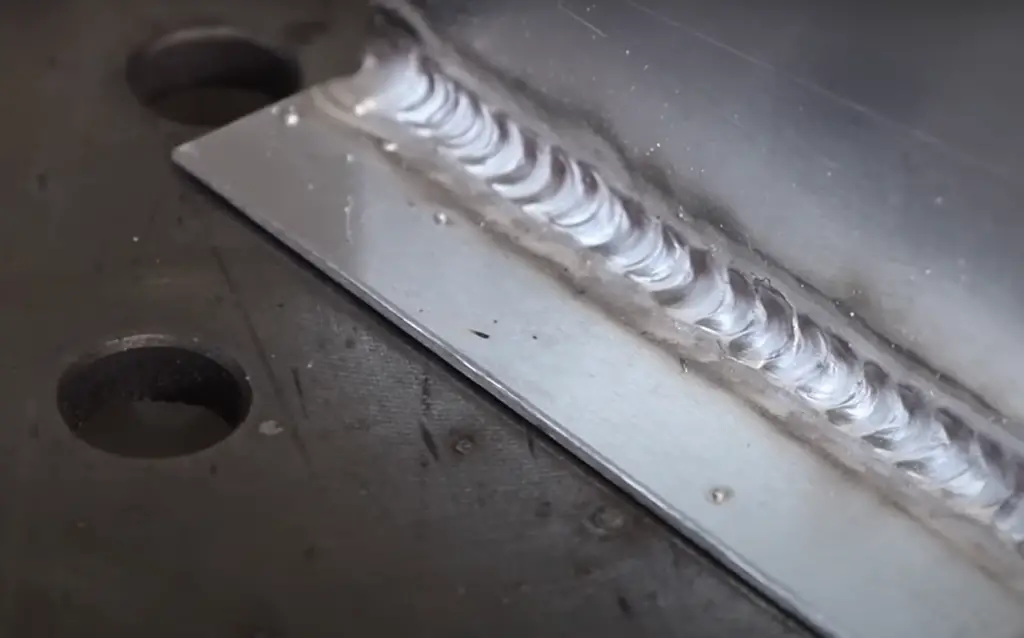
It is an inert gas, meaning it does not react with other gasses or elements. This property makes it ideal for welding aluminum because it prevents contamination of the weld zone and helps to protect the metal from oxidation during the welding process.
Inert Properties
Argon’s inert properties provide several benefits when used for aluminum welding. Because argon does not react with other gasses or elements, it is an excellent choice for creating a stable, uncontaminated environment in which to weld aluminum. Its non-reactive nature allows it to be used at higher temperatures than other shielding gasses and still maintain a protective atmosphere around the weld area.
Benefits of Using for Aluminum Welding
The major benefit of using argon gas for aluminum welding is its ability to create a clean, non-reactive environment around the weld zone. It prevents oxidation from occurring and helps to ensure a quality weld with minimal distortion or spatter. Argon’s high melting point allows it to be used at higher temperatures, making it easier to achieve good results when welding thin metals such as aluminum.
Helium Gas
Helium gas is another common shielding gas used for aluminum welding. It has many benefits, but you should also consider some drawbacks before choosing it for your project.
The Pros and Cons of Using Helium
One benefit of using helium as a shielding gas is its higher thermal conductivity compared to argon. It allows for more heat transfer from the weld area to the surrounding environment, making it easier to achieve good results with thin metals like aluminum. Its low viscosity makes it easy to control during welding processes. On the other hand, helium can be expensive and difficult to obtain in large quantities due to limited availability. While it does help to reduce oxidation, it is less effective than argon at creating a contamination-free environment around the weld zone.
Specific Scenarios Where Helium is Preferred
Helium gas is most often used in applications that require very precise control of heat transfer during the welding process. It includes complicated fabrication projects that involve thin metals such as aluminum or titanium. Helium’s higher thermal conductivity makes it an ideal choice for achieving consistent results with these materials. It can be used in conjunction with argon gas to achieve optimal results when welding aluminum, protecting against oxidation while allowing more heat transfer from the weld area.
Gas Combinations for Enhanced Aluminum Welding
For welders looking to increase the quality of their aluminum welding, combining different gasses can be a great way to achieve optimal results.
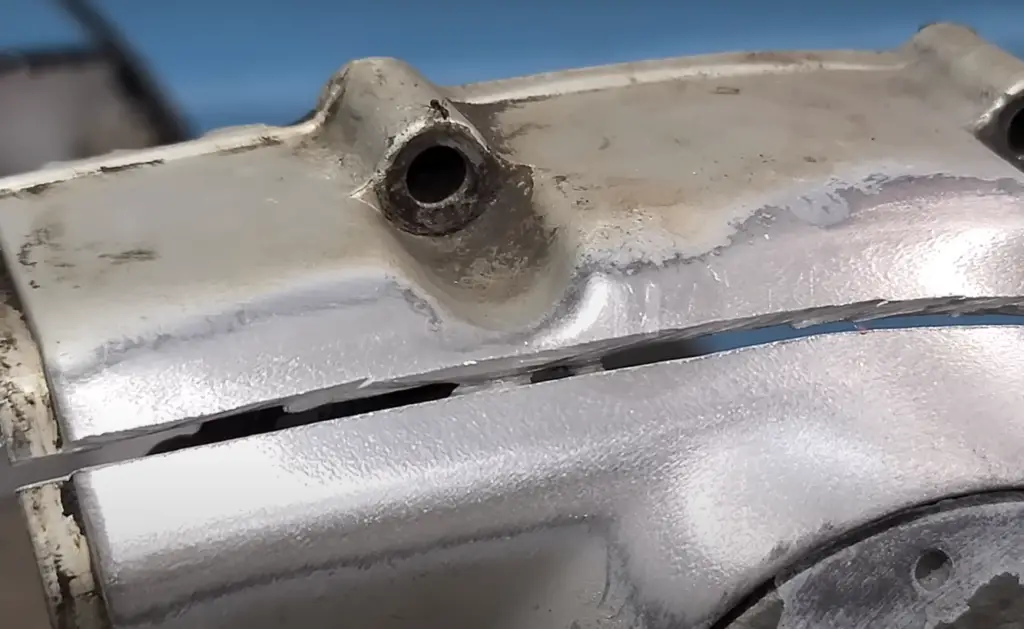
Here are some gas combinations commonly used when welding aluminum:
Argon-Helium Mixtures
Mixtures of argon and helium are often used to optimize the welding process when it comes to aluminum. By combining both gasses, welders can achieve better heat transfer and a more controlled atmosphere around the weld zone, making it easier to produce quality results. However, different ratios must be used for different thicknesses of aluminum to achieve optimal results.
Optimizing Gas Ratios for Different Aluminum Thicknesses
When using argon-helium mixtures for aluminum welding, you should adjust the gas ratio based on the thickness of the metal being welded.
For thicker metals such as aluminum tubing or castings, a ratio of 90% argon and 10% helium is recommended. It will ensure the weld area is protected from oxidation while allowing enough heat transfer to achieve good results.Benefits and Drawbacks of Using Argon-Helium Mixtures
The major benefit of using an argon-helium mixture for aluminum welding is the ability to adjust the gas ratio to optimize heat transfer for different thicknesses of metal. It makes it possible to achieve consistent results with different types of aluminum and can be particularly useful for complicated fabrication projects that involve multiple thicknesses. However, argon-helium mixtures tend to be more expensive than using argon alone, and they require a higher level of skill to achieve good results. On top of that, helium is often difficult to obtain in large quantities due to limited availability.
Argon-Hydrogen Mixtures
Argon-hydrogen mixtures are another popular choice for aluminum welding. This combination is made up of a mixture of argon and hydrogen gasses, which are both inert and do not react with other elements. The primary benefit of using an argon-hydrogen mixture for aluminum welding is that it can create a slightly reducing atmosphere around the weld zone. It lowers the risk of oxidation and helps to ensure high-quality results.
When to Consider Using This Gas Combination
Argon-hydrogen mixtures are best used in certain projects where complete control over heat transfer is desired. It is most often used when welding thick aluminum parts such as castings or tubing due to its ability to reduce oxidation and provide more consistent temperature control.
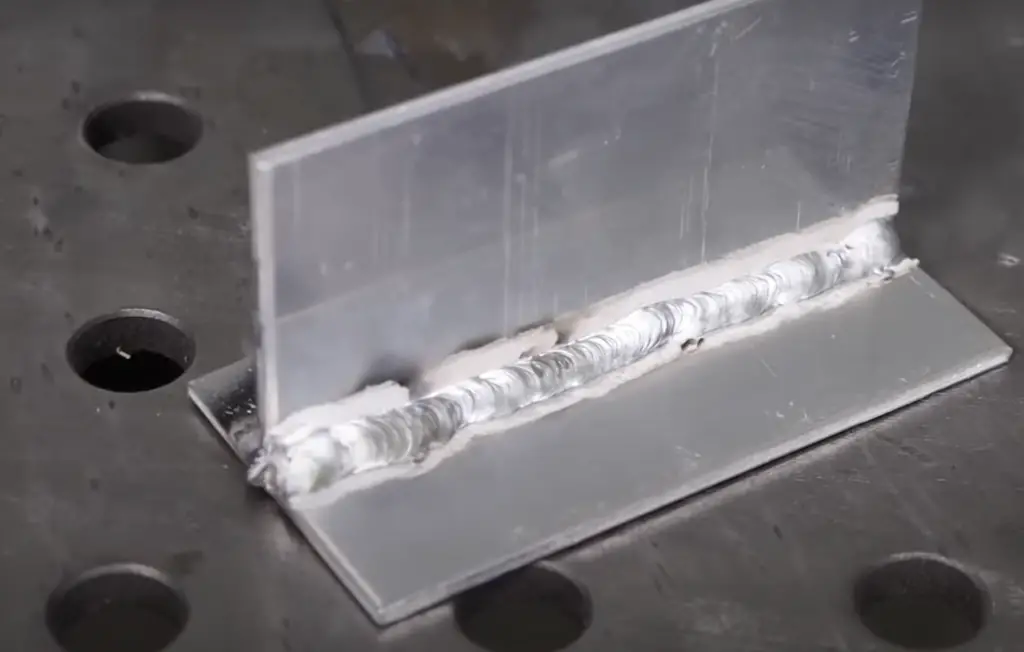
Some welders prefer using this gas combination on thin metals like sheet or plate aluminum because it provides better protection against contamination from other elements in the atmosphere. However, it should be noted that argon-hydrogen mixtures are more expensive than other shielding gas types, so they may not always be the most cost-effective option.
Factors to Consider When Choosing the Right Gas
When selecting the right shielding gas for aluminum welding, there are several factors to consider. These include the type and thickness of the aluminum alloy being welded, the desired weld characteristics, and the welding technique and equipment being used:
- Aluminum Alloy Type and Thickness: The type of aluminum alloy being welded can influence which shielding gas works best. It is because different alloys have different characteristics that require specific conditions to achieve a successful weld. For example, some alloys may require higher temperatures or increased protection from oxidation while others may not. You should consider the thickness of the material as it can affect which gas will provide optimal heat transfer and contamination control around the weld area;
- Desired Weld Characteristics: The desired weld characteristics should also be considered when selecting a shielding gas. For example, if a strong weld is a priority, an argon-helium mixture may be best as it can provide better heat transfer and control of the atmosphere around the weld area. On the other hand, if oxidation protection is more important than heat transfer, an argon-hydrogen mixture could work well;
- Welding Technique and Equipment: The welding technique and equipment being used can also determine which gas will produce optimal results. For example, some welding techniques require greater levels of heat transfer while others are less demanding in this regard. Some equipment may require different ratios of gasses to achieve desired results.
Why Is Aluminum Welding So Difficult?
Aluminum welding can be a difficult process because it requires high levels of skill and precision to achieve good results. The use of the wrong shielding gas mix, incorrect settings on the welder, or other errors in technique can lead to weak welds that may break easily. Aluminum is more sensitive to oxidation than other metals, so controlling the atmosphere around the weld area is especially important. Keeping these factors in mind and taking extra care when welding aluminum can help ensure that strong and durable welds are produced.
What Gas Should I Use When MIG Welding Aluminum?
The most commonly used shielding gas when MIG welding aluminum is an argon-helium mixture. This type of gas is ideal for achieving good heat transfer and creating a controlled atmosphere around the weld zone. However, the exact ratio of argon to helium should be adjusted based on the thickness of the material being welded. For thinner metals such as sheet or plate aluminum under 1/8” thick, a ratio of 95% argon and 5% helium is recommended. For thicker materials like castings or tubing, a ratio of 90% argon and 10% helium is typically used [3].
How to Gas Weld Aluminum: A Beginner’s Guide
By following these steps and taking extra care when welding aluminum, you can ensure that strong and durable welds are produced every time [4]:
Step One: Gather All Necessary Supplies
The first step to gas welding aluminum is to gather all the necessary supplies. It includes a welder, shielding gas, rods, safety gear such as goggles and gloves, and other welding accessories such as a wire brush or chipping hammer.
Step Two: Selecting Your Gas Torch and Rods
After you have the necessary supplies, you’ll need to select a gas torch and rods that are compatible with your welder.
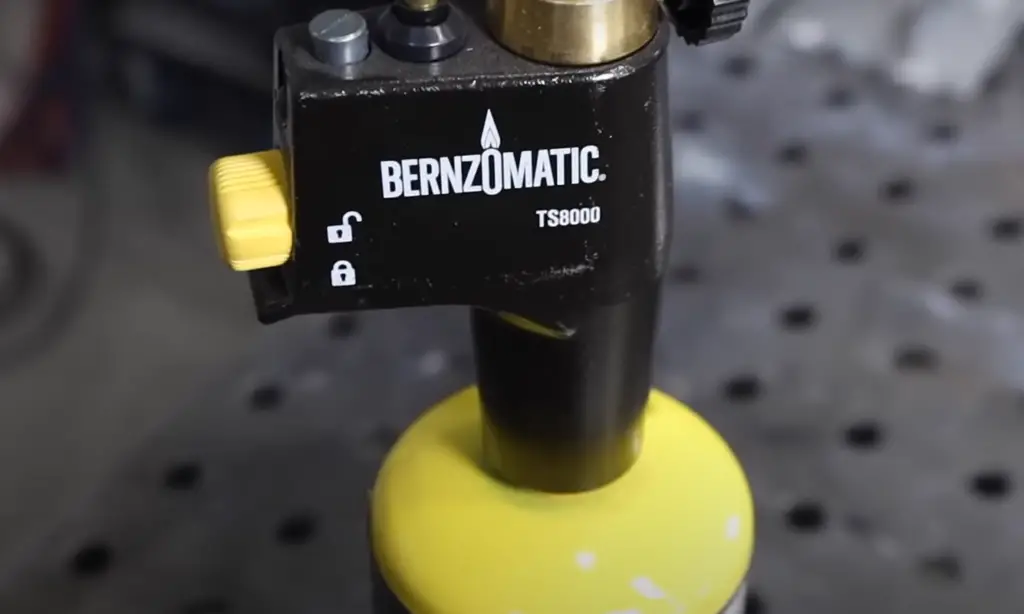
Gas torches are typically made from copper or brass and come in a variety of sizes for different types of welding.
Step Three: Choosing The Right Shielding Gas
The next step is to choose the right shielding gas for your project. The argon-helium mixture offers the best protection against oxidation and heat transfer while an argon-hydrogen mixture can provide more reliable contamination control.
Step Four: Start Welding Aluminum
Once you have your supplies and shielding gas, you can begin welding aluminum. Start by setting the correct voltage, amperage, and wire speed on your welder. Then, adjust the gas pressure to ensure proper flow of the shielding gas around the weld.
Step Five: After-Welding Aluminum Maintenance
Once you’ve finished welding, be sure to inspect the weld for signs of porosity or defects. You should also use a wire brush or chipping hammer to remove slag that may have formed during the welding process. Finally, you should clean off the residue from the weld with a non-abrasive cloth.
What Gas Is Best for Aluminum?
The best shielding gas for aluminum welding depends on the type and thickness of the material being welded, the desired weld characteristics, and the welding technique and equipment being used. A mixture of argon and helium provides the best protection against oxidation and heat transfer while an argon-hydrogen mixture offers more reliable contamination control. Some welding techniques may require specific gas ratios to achieve desired results. Therefore, it is important to consider all of these factors when selecting the right shielding gas for aluminum welding.
What Is the Correct Flame for Welding Aluminum?
The correct flame for welding aluminum should be focused, but not too hot. The heat of the flame should be strong enough to melt the metal, but not so hot that it burns away the shielding gas. The flame should be directed toward the weld area in a sweeping motion to ensure even and consistent heat transfer throughout the weld zone [5].
It is also important to keep the flame moving around the weld area while welding to minimize oxidation. Good practice for welding aluminum also includes preheating or post-heating the metal before or after welding and using inert backings or purging with argon gas to control contamination. Following these steps will help ensure strong and durable aluminum welds every time.
What Are the Welder Settings for Welding Aluminum?
When welding aluminum, the welder settings depend on a variety of factors such as the thickness and type of material being welded, the desired weld characteristics, and the welding technique and equipment being used.
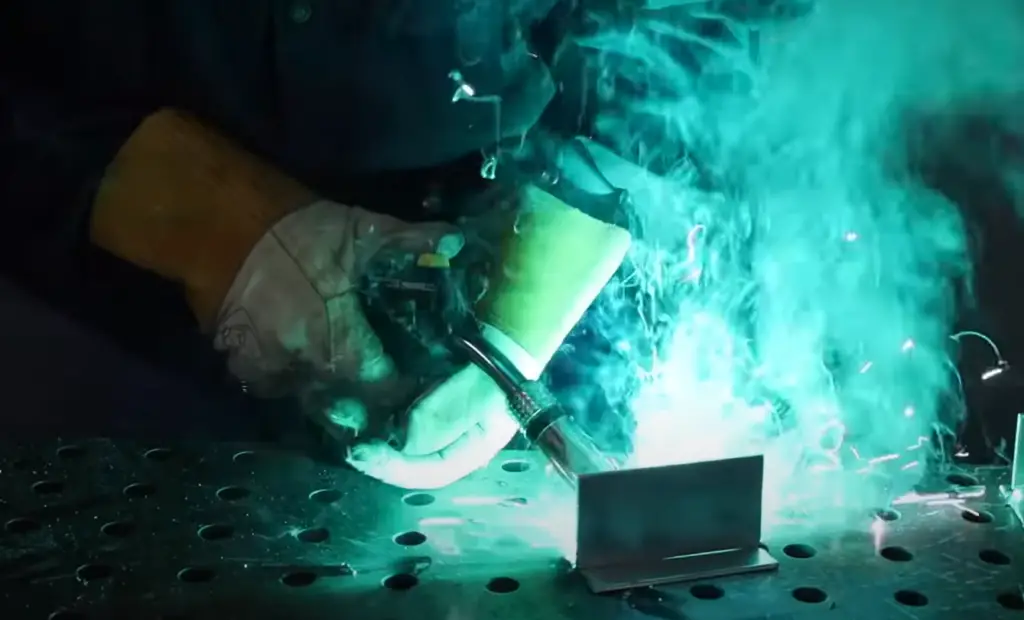
It is best to start with a low voltage (around 10-15 volts) and amperage (around 110-150 amps) before adjusting based on actual results [6].
What Should Aluminum Never Be Welded To?
Aluminum should never be welded to ferrous metals such as steel or iron, as it can cause galvanic corrosion.
Avoid welding aluminum to magnesium or zinc-based metals, as these materials can release toxic fumes when exposed to the high temperatures needed for welding.FAQs
Do You Need 100% Argon to Weld Aluminum?
No, you don’t. You do not need 100% argon to weld aluminum. A mixture of argon and helium is recommended as it provides the best protection against oxidation and heat transfer. Depending on the thickness of the material being welded, the ratio of argon to helium should be adjusted accordingly for optimal results.
Can CO2 Be Used to Weld Aluminum?
No, it cannot. CO2 cannot be used to weld aluminum as the gas is not inert and can cause oxidation of the metal.
Do You Need Different Gas TYpes to Weld Aluminum?
Yes, you do. Different gas types are used for welding aluminum. A mixture of argon and helium is typically used as it provides the best protection against oxidation and heat transfer. Depending on the thickness of the material being welded, the ratio of argon to helium should be adjusted accordingly for optimal results.
Can I Weld Aluminum With Propane?
No, you cannot. You cannot weld aluminum with propane as the gas is not inert and can cause oxidation of the metal.
Why Can’t You Weld Aluminum to Steel?
Welding aluminum to steel is not recommended as it can cause galvanic corrosion due to the different metals reacting with each other [7].
Useful Video: How to MIG Weld Aluminum: The Complete Guide
Conclusion
Gas welding aluminum is a great way to create strong and durable welds. However, you should ensure you have the right supplies, use the right shielding gas, and set the correct welder settings. Aluminum should never be welded to ferrous metals or other aluminum alloys as it can cause galvanic corrosion and other negative reactions. With the right knowledge and supplies, you can ensure your aluminum welds are successful every time.
References:
- https://www.aluminiumleader.com/about_aluminium/what_is_aluminum/
- https://www.express.fr/en/pro-tips/welding-brazing/which-gas-should-be-used-for-welding-aluminium-stainless-steel-tin-zinc/
- https://weldguru.com/best-gas-for-mig-welding/
- https://www.muggyweld.com/2022/01/20/how-to-gas-weld-aluminum/
- https://weldguru.com/aluminum-gas-welding/
- https://www.thefabricator.com/thewelder/article/arcwelding/tig-welding-aluminum-what-you-need-to-know/
- https://www.twi-global.com/technical-knowledge/faqs/aluminium-welding/aluminium-to-steel/

